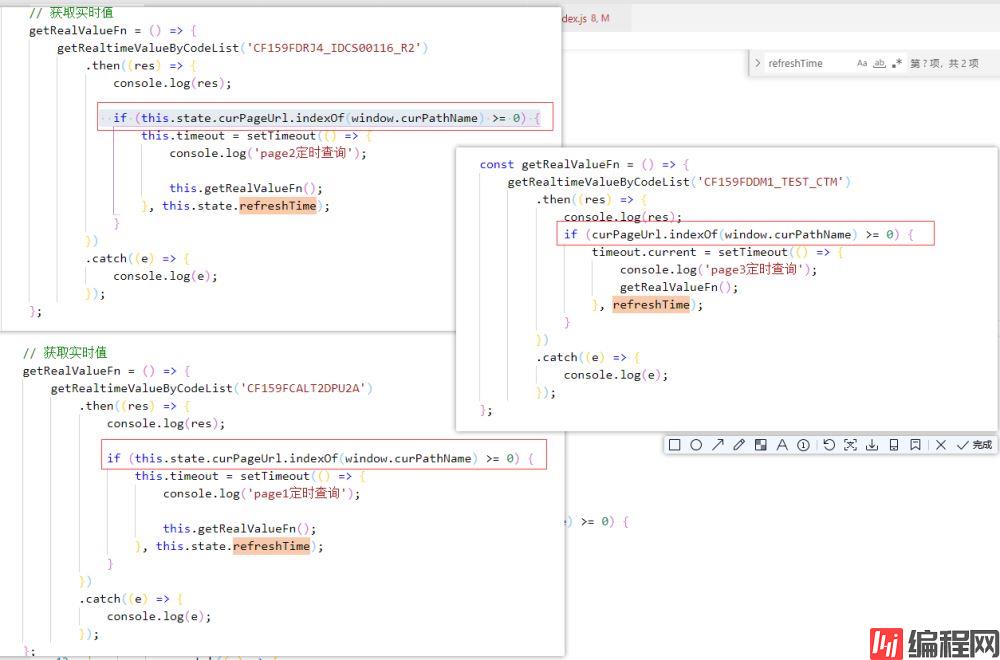目录一、定时器的区别:1、定时器分类:2、setInterval()的使用场景:3、setTimeout()的使用场景4、定时器遇到的问题(以下是我在做项目中遇到的问题及自己的一点想
js有两种定时器分别是setTimeout()和setInterval(),这两个区别就是setTimeout()是一次性的定时器,而setInterval()是循环的定时器。
(1)setTimeout()
只执行一次,在指定的毫秒数之后,就会立即停止
(2)setInterval()
不管语句是否执行完成,不管是否执行错误,到下一次指定的毫秒数后就会立即执行
(3)举例:
比如想调用一个接口,需要1s定时刷新一次,但是接口2s才返回数据,使用setInterval()的话就会出现问题,在上次接口还没有返回结果的情况下,又重新调用了接口,这样交互效果很不好,影响性能;所以在开发中,在遇到接口需要定时的情况,我都会使用setTimeout(),配合clearTimeout使用,需要注意的是:a. 不能把setTimeout写成死循环; b. 注意清除定时器的情况;c. 页面切换清除定时器的情况,这个是重点,也是下面需要讲到的问题
(1)可以使用在动画效果上,比如闪烁效果
(2)其他不需要异步及调用接口的方法 都可以使用(个人的总结,可能不太对)
(3)如果想停止,可以使用clearInterval()或关闭窗口
(1)定时器执行一次的情况下 可以使用,这种场景很少见,这里就不举例了
(2)调用的接口需要定时查询的情况,这种场景很常见,比如天气查询,定时10秒刷新一次,在开发中经常用到
(1)用setTimeout 实现定时查询 一般用于执行的方法中调用后台接口的情况,等接口请求完后,再执行下一次的接口调用; 使用setInterval的话,一般用于不调用后台接口的情况
(2)要是用setInterval用来调用后端接口,可能会有问题,比如定时2s刷新,接口可能会3s才返回接口,还没等这次返回结果去刷新页面,就又去重新查询数据了,可能会造成数据混乱
(3)在使用setTimeout的时候,需要注意的问题就是不要写成死循环;再就是记得清除定时器,清除定时器用clearTimeout 方法
(4)在使用react的时候,会遇到路由切换的情况,有时候会出现定时器清除不掉的情况
比如在A页面中是用了定时器setTimeout,但是没有清除定时器,那么在访问B页面的时候,A页面的定时器还会执行,请求的接口也仍然会继续执行,所以要清除一下,在A页面切换到B页面的时候,会执行组件卸载的方法(componentWillUnmount),在该方法中调用清除定时器的方法(clearTimeout);
有时候可能会失败,比如刚巧在执行componentWillUnmount的时候,恰好代码也执行到定时器执行的调用后台接口的方法中了,还在请求接口,在请求成功到执行下一次定时器的时候,恰好componentWillUnmount方法把之前的定时器清除了,这样虽然清除了上次的定时器,但是那个方法中又再次使用了定时器,这样的话,就会造成清不掉的问题(这个大家可能会遇到这个问题)
(5)上述问题的React示例代码及运行截图
测试页面1的代码:
import React, { Component } from 'react';
import { getRealtimeValueByCodeList } from '../../SVGManagementNew/services/index'; // 引用的查询实时值的接口
export default class TestPage1 extends Component {
constructor(props) {
super(props);
this.state = {
refreshTime: 500 // 500毫秒
};
this.timeout = null;
}
componentDidMount() {
this.getRealValueFn();
}
componentWillUnmount() {
clearTimeout(this.timeout);
}
// 获取实时值
getRealValueFn = () => {
getRealtimeValueByCodeList('CF159FCALT2DPU2A')
.then((res) => {
console.log(res);
this.timeout = setTimeout(() => {
console.log('page1定时查询');
this.getRealValueFn();
}, this.state.refreshTime);
})
.catch((e) => {
console.log(e);
});
};
render() {
return <div>TestPage1</div>;
}
}测试页面2的代码:
import React, { Component } from ‘react’;
import { getRealtimeValueByCodeList } from ‘…/…/SVGManagementNew/services/index’; // 引用的查询实时值的接口
export default class TestPage2 extends Component {
constructor(props) {
super(props);
this.state = {
refreshTime: 500 // 500毫秒
};
this.timeout = null;
}
componentDidMount() {
this.getRealValueFn();
}
componentWillUnmount() {
clearTimeout(this.timeout);
}
// 获取实时值
getRealValueFn = () => {
getRealtimeValueByCodeList('CF159FDRJ4_IDCS00116_R2')
.then((res) => {
console.log(res);
this.timeout = setTimeout(() => {
console.log('page2定时查询');
this.getRealValueFn();
}, this.state.refreshTime);
})
.catch((e) => {
console.log(e);
});
};
render() {
return <div>TestPage1</div>;
}
}
测试页面3的代码
import React, { useState, useRef, useEffect } from ‘react’;
import PropTypes from ‘prop-types’;
import { getRealtimeValueByCodeList } from ‘…/…/SVGManagementNew/services/index’; // 引用的查询实时值的接口
function TestPage3(props) {
const [refreshTime, setRefreshTime] = useState(500);
const timeout = useRef();
const getRealValueFn = () => {
getRealtimeValueByCodeList('CF159FDDM1_TEST_CTM')
.then((res) => {
console.log(res);
timeout.current = setTimeout(() => {
console.log('page3定时查询');
getRealValueFn();
}, refreshTime);
})
.catch((e) => {
console.log(e);
});
};
useEffect(() => {
getRealValueFn();
return () => {
clearTimeout(timeout.current);
};
}, []);
return <div>TestPage3</div>;
}
TestPage3.propTypes = {};
export default TestPage3;
配置三个路由,然后来回切换这三个页面,就会出现定时器清除不掉的情况,三个页面的定时器就会一直在刷新,这样就会造成资源上的浪费及占用内容,要是页面很多、定时刷新的接口很多、接口很耗费资源的话,那么这种情况就会影响整个程序的运行,有可能还会引起系统崩溃

上图就是我在来回切换三个测试页面的时候,出现上述说的问题,可以自己把上述的代码试验下
5、解决上述遇到的第四个问题,即使用setTimeout页面切换时定时器无法清除的问题
a. 解决思路:
(1)从问题的根本出发,问题的根本就是在页面切换的时候,因为定时器缓存的问题,在切换到其他的页面后,无法清除,还会继续在缓存中继续执行;
(2)那么从这个思路上去想,在从A页面(有定时器)跳转到B页面的时候,A页面的定时器没有清除掉,那么是否是可以在A页面的定时器方法那定义个变量,然后在全局定义个变量,然后通过这两个变量来判断是否不执行定时器呢;
(3)根据这个思路去想,那么是否可以根据路由去判断,比如在访问到A页面的时候,在A页面的代码中记录下A页面的路由到一个参数中(该参数在定时器执行的时候,是一块保存到缓存中的,在切换路由的时候,并不会清除,这个是一个存在缓存中的变量),然后在路由切换的时候,监听路由的变化,记录最新访问的路由,保存到window对象中(因为window是全局的,在任何地方都可以使用);
(4)那么这两个变量都有了,然后根据这两个变量判断,如果相等的话,那说明正好是这个页面,可以执行定时器,如果不相等,那么当前访问的页面不是这个页面,那么定时器就不执行了
b. 实现步骤:
(1)在外部定义一个监控方法,可以在main.js中 也可以在index.js中,也可以在路由切换中的文件中,把下面的代码加入进去,注意的是location的获取,有的js文件中可能获取不到
window.onhashchange = () => {
console.log('监听路由变化');
// 获取当前变化的路由
window.curPathName = this.props.location.pathname;
};
下图是我自己添加的位置:

(2)在使用定时器的文件中,设置每个文件使用时访问的路由地址

(3)判断是否加载定时器

c.完整的示例代码,可以正常清除定时器的
测试页面1的代码:
import React, { Component } from 'react';
import { getRealtimeValueByCodeList } from '../../SVGManagementNew/services/index'; // 引用的查询实时值的接口
export default class TestPage1 extends Component {
constructor(props) {
super(props);
this.state = {
refreshTime: 500, // 500毫秒
curPageUrl: '' // 当前页面的访问地址
};
this.timeout = null;
}
componentDidMount() {
const urlParams = window.location.href;
this.setState({
curPageUrl: urlParams
});
this.getRealValueFn();
}
componentWillUnmount() {
clearTimeout(this.timeout);
}
// 获取实时值
getRealValueFn = () => {
getRealtimeValueByCodeList('CF159FCALT2DPU2A')
.then((res) => {
console.log(res);
if (this.state.curPageUrl.indexOf(window.curPathName) >= 0 || !window.curPathName) {
this.timeout = setTimeout(() => {
console.log('page1定时查询');
this.getRealValueFn();
}, this.state.refreshTime);
}
})
.catch((e) => {
console.log(e);
});
};
render() {
return <div>TestPage1</div>;
}
}
测试页面2的代码:
import React, { Component } from 'react';
import { getRealtimeValueByCodeList } from '../../SVGManagementNew/services/index'; // 引用的查询实时值的接口
export default class TestPage2 extends Component {
constructor(props) {
super(props);
this.state = {
refreshTime: 500, // 500毫秒
curPageUrl: '' // 当前页面的访问地址
};
this.timeout = null;
}
componentDidMount() {
const urlParams = window.location.href;
this.setState({
curPageUrl: urlParams
});
this.getRealValueFn();
}
componentWillUnmount() {
clearTimeout(this.timeout);
}
// 获取实时值
getRealValueFn = () => {
getRealtimeValueByCodeList('CF159FDRJ4_IDCS00116_R2')
.then((res) => {
console.log(res);
if (this.state.curPageUrl.indexOf(window.curPathName) >= 0 || !window.curPathName) {
this.timeout = setTimeout(() => {
console.log('page2定时查询');
this.getRealValueFn();
}, this.state.refreshTime);
}
})
.catch((e) => {
console.log(e);
});
};
render() {
return <div>TestPage1</div>;
}
}
测试页面3的代码:
import React, { useState, useRef, useEffect } from 'react';
import PropTypes from 'prop-types';
import { getRealtimeValueByCodeList } from '../../SVGManagementNew/services/index'; // 引用的查询实时值的接口
function TestPage3(props) {
const [refreshTime, setRefreshTime] = useState(500);
const [curPageUrl, setCurPageUrl] = useState(window.location.href);
const timeout = useRef();
const getRealValueFn = () => {
getRealtimeValueByCodeList('CF159FDDM1_TEST_CTM')
.then((res) => {
console.log(res);
if (this.state.curPageUrl.indexOf(window.curPathName) >= 0 || !window.curPathName) {
timeout.current = setTimeout(() => {
console.log('page3定时查询');
getRealValueFn();
}, refreshTime);
}
})
.catch((e) => {
console.log(e);
});
};
useEffect(() => {
console.log(curPageUrl);
getRealValueFn();
return () => {
clearTimeout(timeout.current);
};
}, []);
return <div>TestPage3</div>;
}
TestPage3.propTypes = {};
export default TestPage3;
到此这篇关于JS中定时器的使用及页面切换时定时器无法清除问题的解决办法的文章就介绍到这了,更多相关JS定时器无法清除解决内容请搜索编程网以前的文章或继续浏览下面的相关文章希望大家以后多多支持编程网!
--结束END--
本文标题: JS中定时器的使用及页面切换时定时器无法清除问题的解决办法
本文链接: https://www.lsjlt.com/news/194431.html(转载时请注明来源链接)
有问题或投稿请发送至: 邮箱/279061341@qq.com QQ/279061341
下载Word文档到电脑,方便收藏和打印~
2024-01-12
2023-05-20
2023-05-20
2023-05-20
2023-05-20
2023-05-20
2023-05-20
2023-05-20
2023-05-20
2023-05-20
回答
回答
回答
回答
回答
回答
回答
回答
回答
回答
0